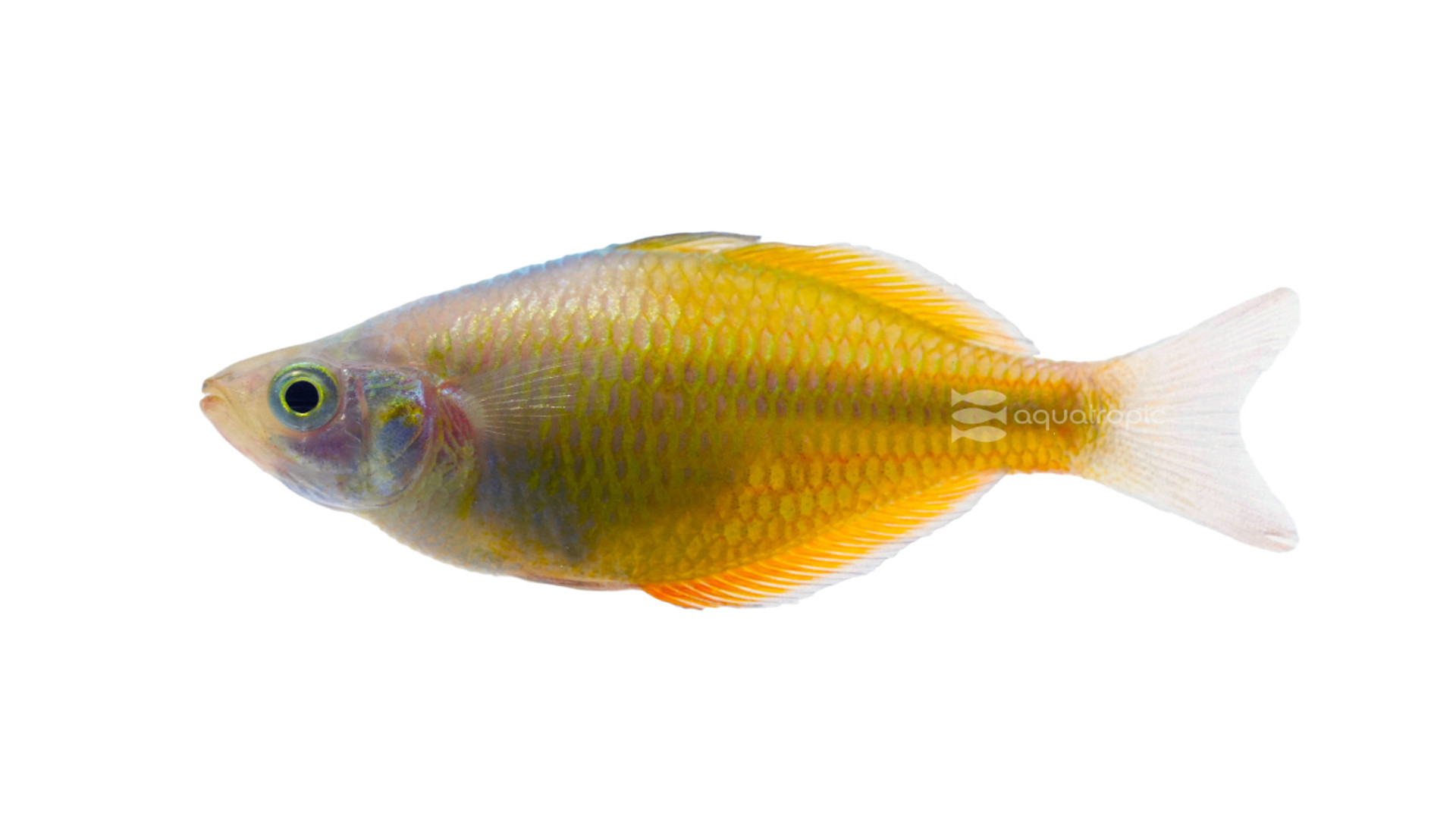A Rainbow of Yellow

There are quite a few fish that are called “Rainbow” in one way or another. It's easy to see why with the full gamut of iridescent colors that regularly show up in the aquarium world. The fish that most hobbyists recognize as Rainbowfish come from the genus Melanotaenia. The Yellow Rainbowfish (Melanotaenia herbertaxelrodi) has really only one other common name in English, which is the Lake Tebera Rainbowfish. It carries this name because the Lake Tebera basin (the lake and all the creeks, streams and swamps that drain into it) is the only place the Wild Yellow Rainbow has ever been found (with one possible exception). Most of the non-English names all translate back as some combination of Yellow or Gold and Rainbow and Fish, our favorite being the Finnish title, Kultasateenkaarikala! Go ahead and twist your tongue around that one!
The Lake Tebera basin is high in the mountains of southern Papua, New Guinea. The lake itself is very large and sits at an altitude over 2600 feet and the surrounding mountains reach up to nearly 5000! Like most of New Guinea, the area is a rainforest and many small streams and marshes that continually feed the lake. The wild Yellow Rainbowfish tend to live in clear water areas of the lake and tributary streams that have dense cover and vegetation. In part because their native range is so constricted and because they are a uniquely beautiful fish, well suited for aquarium life, they could be vulnerable to overfishing.
Luckily, these gorgeous swimmers are also easily aquacultured, and as such, nearly all of the specimens you see in your local fish store (and all of the individuals that come from Aquatropic) are captive bred and raised. For those of you interested in breeding Melanotaenia herbertaxelrodi in your home aquarium, the process is very straightforward.
Spawning can be triggered by large, slightly warmer water changes. Females ready to spawn will fatten up and the males will seem even more brilliantly colored and very actively displaying to other males. Females will scatter eggs that will settle on vegetation (or mops if you prefer). Pairs will spawn daily for weeks, laying multiple batches of eggs per day. Adults rarely eat the eggs, or fry and they can be left in the display, though people generally have better success raising the fry in separate locations. Eggs will hatch in a week to a week and a half. The fry raising is the only tricky part of this process as they are very small and will require miniscule foods like infsoria (see our article on homegrown food – infusoria). Fry will stay near the water's surface, so floating foods will be more easily targeted to them.
Yellow Rainbowfish should be kept in groups, and a good distribution is a couple females for every male. Ideally you will keep nine or more, with three as a bare minimum. They can get to be three or four inches long, so plan your display size with this in mind. A tank with nine of them would need to be at least 40 gallons, and 55 or 75 would be even better. These tanks don't require substrate, but as these fish love densely planted aquariums, appropriate substrate for plants will make this easier. They are no risk to any of your plants, and thus make the perfect fish for displays featuring fine and soft leaved plants. The more places these fish have to hide, the more colorful and gregarious they will be.
Water quality should be good, and we recommend regular water changes. They'll do best and be most likely to spawn in aquariums that have water with a pH between 7 and 8 and will fail to thrive in water that is below this threshold. You should shoot for very limited nutrients, very clear water, and temperatures in the 70s F. They prefer hard water and a hardness over 10 degrees is best, especially for spawning and raising fry.
Melanotaenia herbertaxelrodi are omnivores that are easily fed. They should be given a high-quality pellet with a rounded profile. In house they get Nutramar's Algae and Color Boost Pellets, along with a quality, floating flake. Even the adults tend to stay in the top to the middle of the water column, so if feeding a sinking food, be sure to do it gradually over a few feeds, so all the food can get consumed before it drops out of their sphere of attention, unless you are keeping them with fish that live and feed lower in your tank's water column. Giving them a selection of frozen and live foods as treats will further enhance their coloration and give their immune systems a boost. Do not rely on foods with a very dense protein like bloodworms for the bulk of their food, but these would be fine as occasional treats.
Your Yellow Rainbowfish will be the most active, and the most colorful in the morning, so spend some time around your tank during your morning routine. They do well with most other fish as long as those fish aren't overly aggressive. Some people even keep them with the more peaceful cichlids. Other good choices are Danios, Tetras, Corydoras and Otos. They are fine to keep with invertebrates, though shrimp that are small enough for them to eat may be at risk.
Rainbowfish of all sorts are Freshwater aquarium royalty, and the Yellow Rainbowfish is no exception. If given parameters and environments they like, they are hardy and active. Their iridescent colors have very few peers, even on the saltwater side of the hobby. They are easy to feed and peaceful. If you are interested in a group of stunning fish, appropriate for your planted aquarium, it's going to be hard to find a better fish that the Yellow Rainbowfish. Head to your LFS and ask them for aquacultured Melanotaenia herbertaxelrodi from Aquatropic today!